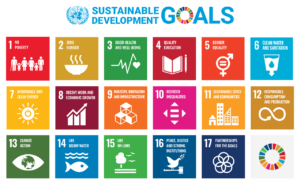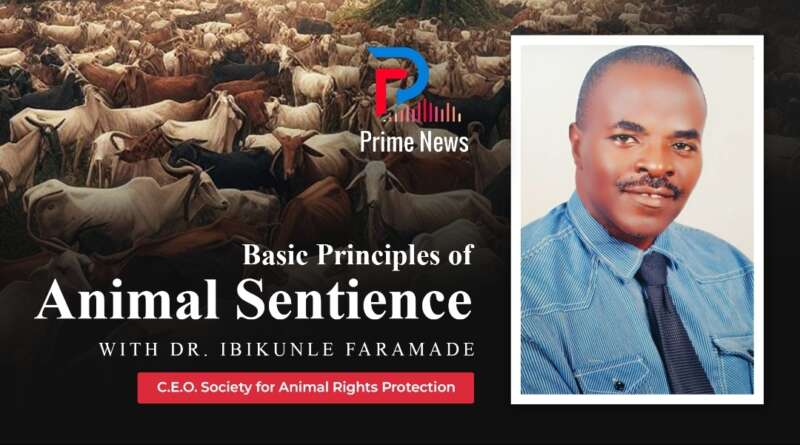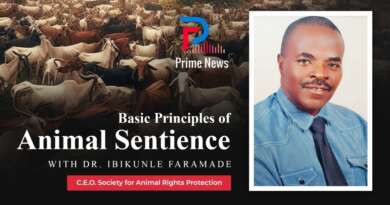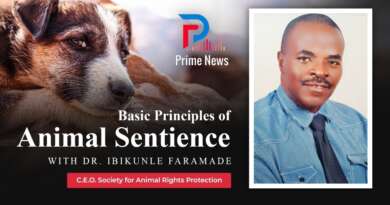Animal Welfare and the Achievement of Sustainable Development Goals 3
By Dr Ibikunle Faramade
… Continued
The nexus between animal welfare and the achievement of sustainable development goals 1-4 was discussed last week. This week, we shall continue the discussion as it relates to other SDG goals. This is very crucial in order to reinforce the fact that the achievement of SDGs by the year 2030 requires a multi stake holders approach to the benefit of our society.

Goals 5: Achieve gender equality and empower all women and girls
The connection of animal welfare with the achievement of SDG 5 is very direct. As previously mentioned, women and girls are known to be involved in the rearing of certain categories of animals, especially, poultry, sheep, goat, pigs and small number of dairy cows. The more the welfare of these animals are looked after, the more their contributions to sustainable livelihood of women especially. Boosting sustainable livelihood of women through adequate welfare of their animals (owned in small numbers) would bridge the gap of economic inequality between men and women, thereby, reducing the problem of poverty at the family level.
Goal 6: Ensure availability and sustainable management of water and sanitation for all.
The goal of assurance of availability of water and sustainable management of water and sanitation cannot be achieved without adequate consideration and deliberate water policy for animals, especially, large animals. The practice of open grazing or transhumance is age hold and deeply cultural, most especially in sub Saharan Africa. Because of the challenge of urbanization and population explosion in Nigeria, most grazing routes and grazing corridors are now obstructed by housing estates and crop farm settlements. There is widespread contamination of streams and rivers which are the major sources of drinking water for some rural dwellers by animal waste products. That’s why the issue of ranching or semi- intensive food animal production is germane. Humans need water, animals need water, and plants need water. Water is central to the balance of ecosystem. Solving the problem of availability and accessibility of water for animals is central to achieving SDG 6.
Goal 7: Ensure access to affordable, reliable sustainable and modern energy for all
In some intensive poultry (deep litter system) and livestock management systems, the management of waste products have become a major challenge. Animal waste products are now used to generate biogas. As we make the animals comfortable by regular removal of wastes to prevent diseases etc, the target of achieving affordable reliable and modern energy for all will be achievable, leading to a win-win situation.
Goal 8: Promote sustained, inclusive and sustainable economic growth, full and productive employment and decent work for all.
The animal resources subsector of agriculture is a significant contributor to per capita income globally. In Nigeria, about 70% of the population are believed to be engaged sustainably in one form of agricultural enterprise or the other. A good percentage of this population are involved in animal production. If the third freedom of animals (freedom from pain, injury and diseases) is ensured, undoubtedly, inclusive and sustainable growth, full productive employment and decent work would be guaranteed. For example, avian influenza (bird flu), African swine fever, Peste de Petit Ruminantum have caused a lot of havoc for many framers. Any effort geared towards the occurrence of these diseases and many more would have direct impact in the achievement of SDG 8.
Goal 12: Ensure sustainable consumption and production patterns
This goal cannot be achieved, especially as it concerns wild life (terrestrial and aquatic). The enforcement of relevant provisions of the law that forbids over- exploitation of wild animals consumed as venison (bush meat), or killing of endangered species is very crucial. The relentless parliamentary advocacy of Honorable Mohammed Datti for the protection of donkeys from going to extinction is highly commendable in this regard. Donkeys are domestic animals that are renowned as beasts of burden. Unfortunately, they are slaughtered for their meat, hide and for alleged medicinal value. The gestation period of donkeys range from 11-14 months with an average of 12 months. Their long gestation period and the fact that twinning is rare makes their population to be declining because the slaughter rate exceeds their birth rate. This is not peculiar to donkeys as it affects some other endangered species.
Goal 14: Conserve and sustainably use the oceans, seas and marine resources for sustainable development
The welfare of aquatic animals in seas and oceans has direct positive effects on their conservation. Industrial pollution in form of toxic chemicals and plastics hampers their welfare and well-being with deleterious effects on their reproduction and sustainability. Therefore, any effort directed to improve the welfare of marine animals will eventually lead to the achievement of SDG 14.
In conclusion, the benefits accruable to human societies through the pursuit of animal welfare are numerous. Invariably, animal welfare, ultimately, is equal to human welfare. After all, science has shown that humans could be classified as higher animals.
Concluded.
Dr. Ibikunle Faramade is a veterinary pathologist, sustainable development practitioner and a lecturer at the Federal College of Animal Health & Production Technology, Apata. Ibadan. He’s the C.E.O of the Society for Animal Rights Protection, a non-profit and a non-governmental organization dedicated to the promotion of animal welfare, animal rights and prevention of cruelty to animals. animalrightsprotection2020@gmail.com , +2348028305284



